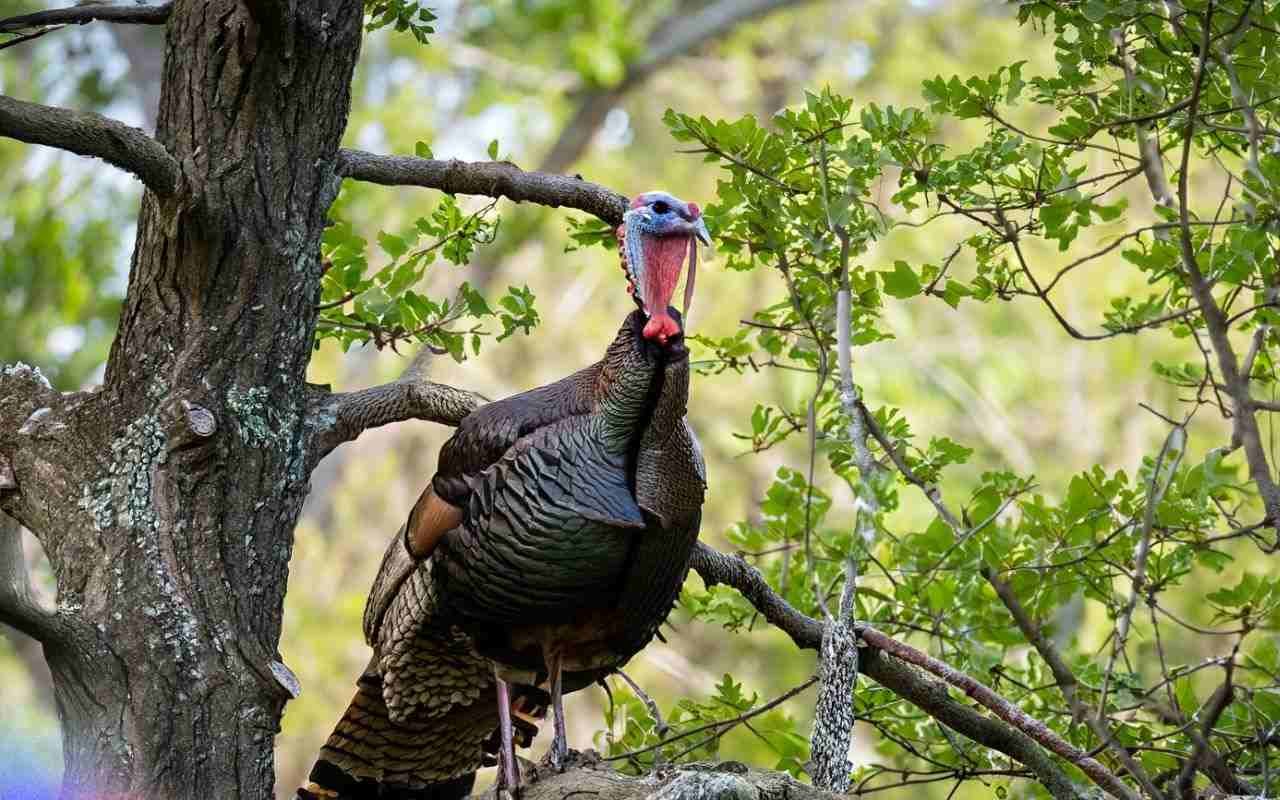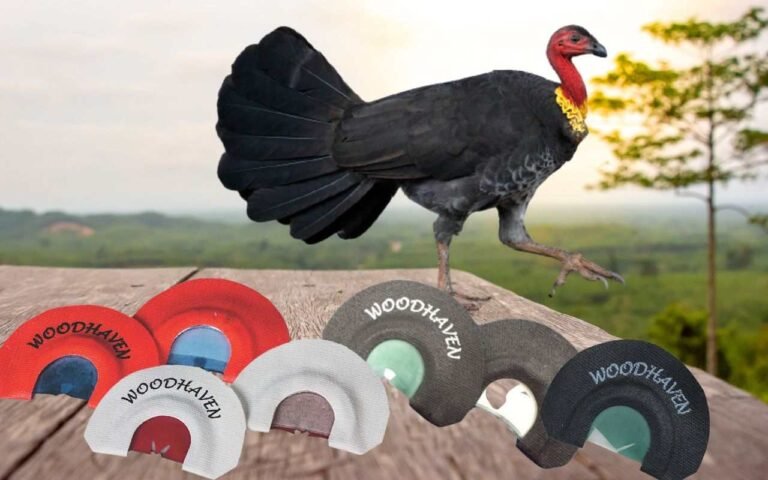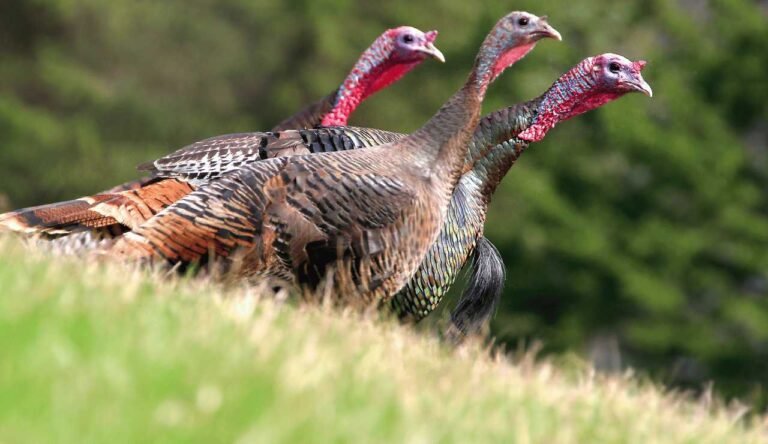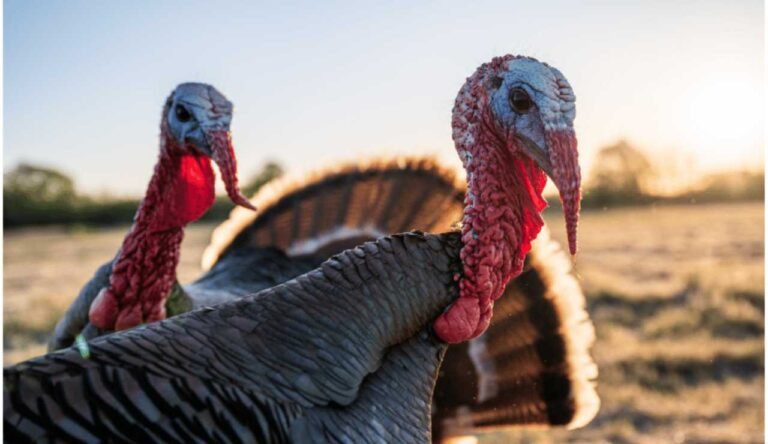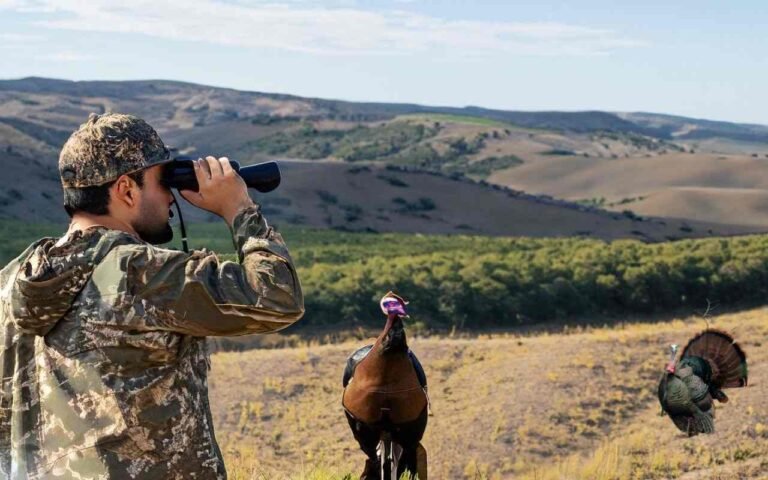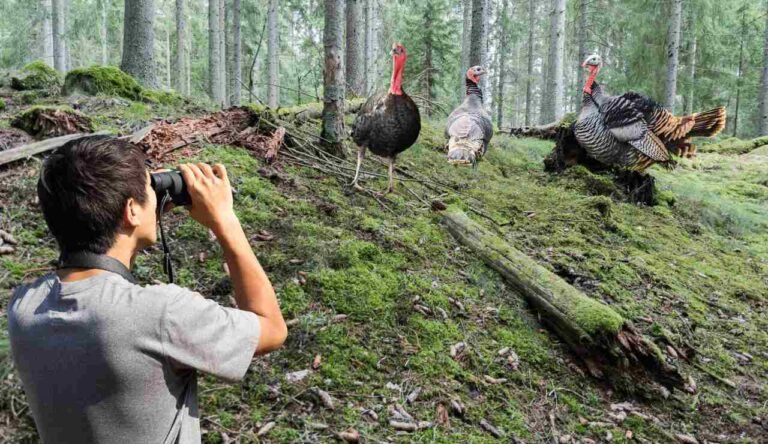Wild Turkey Habitats Unleashed: A Closer Look at the Dynamic Habitats of Wild Turkeys!
The wild turkey is a magnificent game bird that has enthralled outdoor enthusiasts for ages. Knowing the perfect environment for these cunning birds offers important insights into their habits and tendencies, enabling hunters to identify good turkey area. Explore streams that are home to these spirited birds, survey green meadows before daybreak, and walk on woodland floors strewn with fall leaves. Discover the amazing habitat to which the wild turkey has adapted over most of North America. We’ll look at the characteristics that provide healthy and alluring surroundings for these well-liked game birds, from deep woods to edge habitats.
Wild Turkey Habitat
In North American hunting customs, wild turkeys have a unique position. Understanding their habitats is crucial because to their cunning, seasonality, and adaptability. Before packing the vehicle and camo for a turkey hunt, study their region.
This page explores wild turkey habitats. Seasonal fluctuations affect their habitat choices throughout the year. Mast crops, shelter, water, and strutting grounds matter. We’ll provide techniques for finding good turkey locations near you.
You’ll learn to interpret turkey sign in different environments by the end. Let’s start unraveling wild turkey habitats!
| Wild Turkey Habitats | Description |
|---|---|
| Subspecies and Habitats | Wild turkeys have subspecies suited to diverse settings. Eastern, Osceola, Rio Grande, and Merriam's Wild Turkeys are subspecies. They've adapted to deciduous forests, meadows, and mountains. |
| Habitat Diversity | Wild turkeys use several environments. They utilize mature woods, fields, edge habitats, and riparian environments. This variety ensures year-round food, refuge, and nesting. |
| Wooded Areas | Turkey habitat is mature woodlands and forests. Eastern, Osceola, and Merriam's turkeys use mixed-conifer deciduous hardwood woods. Rio Grande turkeys like cottonwood riparian woodlands and meadows. These places offer nuts, berries, insects, shelter, and roosting. |
| Edge Habitats | Turkeys may forage and feel comfortable in edge environments like field-forest borders. Turkeys may graze and run into the woods. Combining foraging from both ecosystems gives these places food variety. |
| Seasonal Shifts | Turkeys favor seasonal habitats. They prefer thickets for mating and nesting in spring. They raise broods in forests near water in summer. They hunt for abundant harvests and roost in tall trees in fall. They seek tree-filled shelters in winter. |
| Roosting Behavior | Turkeys sleep in trees to avoid predators. Due to their height and solid branches, Merriam's turkeys favor mature oaks, poplars, and pines for roosting. They prefer trees that are far from ground action and allow quick morning fly-down to feeding locations. |
| Human Impacts | Habitat loss from roads, building, and agriculture has diminished turkey habitat. Overgrazing and inappropriate logging damage their ecosystems. Conservation has recovered turkey populations in overexploited regions. Their survival depends on sustainable land use and habitat conservation. |
| Conservation Considerations | Ethical hunters protect turkey populations. Supporting habitat preservation groups, lobbying for diversified forests and careful wood cutting, and opposing unnecessary construction in crucial wildlife regions helps turkey habitat conservation. |
The Wild Turkey’s Native Range in Focus
Only North America is home to wild turkeys. Tens of thousands of these birds were reported in flocks by early European immigrants. But by the early 1900s, turkeys had been driven out of most of their area as a result of overhunting and habitat destruction. Wild turkey populations saw a spectacular recovery because to committed conservation initiatives in the mid- to late 1900s.
| Subspecies | Habitat Characteristics |
|---|---|
| Eastern Wild Turkey | Deciduous woods of the eastern and central United States |
| Osceola Wild Turkey | Florida's central and southern regions |
| Rio Grande Wild Turkey | Central plains and Rocky Mountains |
| Merriam's Wild Turkey | Semi-arid environments, pine woods, and mountains in the west |
Today, a large portion of the wild turkeys’ original territory has been successfully recreated. There are sections of them in all 49 U.S. states (Alaska has no native people), as well as in parts of Mexico and Canada. There are four different subspecies, each of which has evolved to suit its native habitat:
- Eastern Wild Turkey – Found in the eastern and central United States’ deciduous woods.
- Osceola Wild Turkey – Florida’s center and southern regions are home to the Osceola Wild Turkey.
- Rio Grande – The Rio Grande Wild Turkey is a species that inhabits the central plains and Rocky Mountains. It is named after the Rio Grande River.
- Merriam’s Wild Turkey – Adapted to semi-arid environments, pine woods, and mountains in the western states.
The secrets of creating ideal conditions for turkeys may be discovered by understanding the primary habitats that each subspecies favors in its native range. Let’s now examine the habitat elements that constitute good turkey real estate.
Characteristics of Ideal Turkey Habitats
Wild turkeys have an astute habit of not putting all of their habitat-related eggs in one basket. They make use of several nearby environments in their native area. Greater availability to food, shelter, nesting locations, and partners is made possible by this variety. However, certain essential habitat characteristics never change.
Wooded Areas Provide a Forest Feast
The foundation of the habitat for turkeys across their range is mature woodland and forest ecosystems. Deciduous hardwood woods with conifers intermingled are frequently used by Eastern, Osceola, and Merriam’s turkeys. Rio Grande turkeys still depend on cottonwood riparian woods but include more open grasslands.

Why do turkeys swarm to wooded areas? They feast on a variety of nuts, seeds, berries, blooms, insects, and shelter there:
Acorns, beech, hickory, and other nuts are prized by mast crops. Turkeys will travel far in search of abundant mast crops.
- Diversified trees, bushes, and openings are advantageous to turkeys since they have a diversified palette. This offers a variety of foods throughout the year.
- Protection – Mature forests provide opportunities for roosting, weather protection, and predator hiding.
The Allure of Edge Habitats
An “edge” is the transitional area where two habitat types meet, such as the line dividing a field from a forest. For turkeys, these edges provide the best of all worlds.
Turkey hotspots are created by the forest margins next to open spaces. They may forage in the wide spaces of the grass here and swiftly flee into the safety of the woods. By combining forage from the open countryside with forest mast, edge habitats also provide essential dietary diversity.
Examples of advantageous edge habitats include field boundaries, logging roads, forest fire breaks, stream corridors, and powerline cuttings. Hunters with a keen eye concentrate on these fringe habitats while scouting.
Seasonal Shifts in Habitat Use
Although wild turkeys retain their primary home ranges, their seasonal habitat choices change as a result of changes in their demands for food and shelter:
- Spring: Open woodlands close to fields in the spring for mating rituals. Nests among bushes and thickets.
- Summer: Forested locations close to water for raising broods. Poult feeding in openings with bugs.
- Fall: Looks for bumper crops. In big trees, it roosts.
- Winter: Areas with plenty of trees provide protection. will enter fields when a storm has uncovered food.

This cyclical migration emphasizes how crucial it is to have a variety of habitats throughout the terrain. Now let’s take a deeper look at some particular habitats that wild turkeys depend on.
| Season | Habitat Use |
|---|---|
| Spring | Mating rituals, nests among bushes |
| Summer | Forested locations near water |
| Fall | Bumper crops, roosting in big trees |
| Winter | Areas with plenty of trees for shelter |
Taking a Stroll Through Turkey Woods
Turkey habitat is unquestionably supported by deciduous woods in the eastern, southern, and midwestern areas. But what precise aspects of a woods make it ideal for turkeys? Observe the following:
Mature Stands with Mast-Producing Trees
Turkey paradise is found in mature highland hardwoods and mixed forests with nut-producing trees. Crucial carbohydrates for the autumn and winter are produced by trees like oaks, beech, hickory, and chestnut.
Turkeys will travel far and wide in search of abundant acorn harvests. While you’re out on the hunt, keep an eye out for signs of where the turkeys are entering and leaving the woods.
Diversity in Structure and Age
Turkeys thrive all year long in wooded areas with a mix of old and young trees and a clear understory. This offers increased food diversity, roosting possibilities, brood habitat, and nesting cover.
To enhance the quality of the habitat, think about selective thinning if the understory is too thick. Opening the canopy promotes development of the understory as well.
Downed Trees, Brushy Cover
While old woods are best, turkeys may still thrive from little disturbance. Trees that have been toppled by wind, fire, or logging provide cover. A scattering of bushes, vines, and young trees also provide cover and places to build a nest.
Openings Within Woods
Prime hunting grounds are found in mature woods along streamsides, logging roads, footpaths, and small fields. Keep an eye out for turkey footprints that go back and forth between openings and the woods. At dawn and dark, hunt the field borders as the turkeys come and go.
Fields of Dreams: Grasslands for Food & Frolic
In addition to woods, both natural and artificial grasslands play a significant role in wild turkey habitat. Food diversity and strutting grounds are provided by pastures, meadows, grasslands, croplands, and old fields. These are their values:
Abundant Forage Options
To vary the food of the turkey, open grassy regions provide seeds, greens, berries, grasses, and insects. Keep an eye out for native species and local favorites such as clover, alfalfa, wheat, and rye.
Even though it may happen all day, field feeding is most active in the morning and evening. Scouting should concentrate on routes that connect farms and woodlands.
Prime Stuttering Locations
On public “gobbler strutting grounds,” male turkeys go on elaborate mating displays, fanning their feathers, dragging their wings, and puffing out their chests.
The best pastures have chickens close, little vegetation on the ground for visibility, and neighboring woodlands for safety. Every year, dominant longbeards visit their preferred open areas.
The advantages of crop rotation
Early successional habitat is preserved by bare ground, hay fields, rotating row crops, and tiny grains. Different phases provide foraging opportunities, bugging grounds, and dusting areas.
Turkey populations are drawn to farmlands’ mosaic of habitat types when they are near wooded areas.
Riparian Areas: A Reception Area and Watering Hole
Ponds, marshes, swamplands, and river and stream corridors provide water in addition to a wealth of food and shelter. When scouting, look for indications of these riparian zones.
Rivers & Streams
Along the banks of creeks and river bottoms, lush foliage, seeds, insects, and berries grow abundantly. Grit from rivers also helps with digestion. From the agricultural margins to the forests, follow these routes.
However, refrain from disturbing birds in confined rivers. Instead, keep track on movement patterns for a distant ambush.
Wetlands and Ponds
Around backwater ponds, insects, minnows, and aquatic plants are attractive to turkey broods. Seed heads may be seen in flooded regions. However, hunting close to water calls for caution and expertise.
Roost Review: Where Turkeys Spend the Night
Wild turkeys use roost trees all year long to be safe at night. Open fly-down access, safety from ground predators, and branches that are easy to grasp and balance on are all characteristics of ideal roosts. Learning about roosting behaviors may help us understand local turkey trends.

| Roost Features | Preferred Trees |
|---|---|
| Mature Trees | Large oak, cottonwood, maple, poplar (east), pine (west) |
| Safety and Height | Remote from ground predators, greater height |
| Roaming Roosters Behavior | Gobblers roost anywhere, less predictable |
Mature Trees Are Preferred
In the eastern and central areas, large oak, cottonwood, maple, and poplar trees are often used as roosting locations. In the west, Merriam’s turkeys often nest in pine trees.
Greater height makes it possible to see danger sooner. Large branches support the weight of the bird and make takeoff simple.
Safety First
Turkeys choose roosting in trees that are remote from constant ground motion. However, they want early morning fly-down access to feeding locations.
Favorite roosts may be used by groups for several years. Under roost trees, take note of any communal droppings or molted feathers.
Roaming Roosters
Gobblers are roving birds that may roost anywhere, unlike hens who choose their usual roosts. Set up farther out along fly-down zones rather than assuming roosting gobblers would remain put.
Human Impacts: Conservation Considerations
Both positive and negative effects of land management techniques may have a big influence on regional populations of turkeys. Knowing these factors makes it easier for ethical hunters to provide a healthy environment for turkeys.
| Impact | Effects on Turkey Habitat |
|---|---|
| Habitat Loss | Reduced habitat is caused by agriculture, roads, and construction. |
| Poor Forestry Practices | Overgrazing, inappropriate logging, and mowing damage environments. |
| Conservation Successes | Turkey populations are thriving as a result of restoration initiatives. |
Habitat Loss
Wooded areas are destroyed and fragmented by construction, roads, and agriculture. Forests deteriorate when fires are suppressed. Because of this, there is less appropriate habitat for turkeys.
Support organizations that safeguard important ecosystems. Speak out against pointless development in important wildlife regions.
Poor Forestry Practices
Openings are harmed by overgrazing, frequent mowing, and thick pine plantings. Woodlots’ roosts and mast-producing trees are removed when they are clear-cut.
Encourage diverse forests, prudent wood harvesting, and rotational grazing practices. Leave the dead tree snags that are used for roosting.
Conservation & restoration
The wild turkey is one of conservation’s greatest success stories because of teamwork in restoration efforts. In traditionally overexploited areas, their numbers are currently thriving.
But for this heritage to live on, habitat protection and ethical hunting methods are essential. For the next generation of hunters, our efforts can guarantee robust turkey populations.
Scouting Wild Turkey Habitat Near You
After discussing the preferred habitats for turkeys, the following advice may help you identify potential locations nearby:
- Look for a diversity of habitats. Turkey hotspots are created by woodlands that are close to fields or openings. Ambush locations are available along interstate highways.
- Keep an eye out for habitats around the edges. Turkeys travel extensively along stream corridors, logging roads, and forest borders.
- Look out for use hints. Active regions may be identified by feathers, trails, dust storms, droppings, and scratching.
- Locate sources of seasonal food. In the spring, scan the fields for greens and seeds; in the autumn, look for mast trees.
- Identify the strutting areas. Be on the lookout for feathers, trails, and dust puddles in open fields or woodland areas.
- Watch out for gobbles. By the morning chorus, locate fly-down areas and roost trees. Calling is also produced by approaching hens.
- Use this information to identify potential habitat for turkeys in your hunting locations. Then use shrewd strategies to have a close encounter with these exceptional game birds.
Conclusion: A Toast to Turkey Habitat Diversity
The annual shuffling of wild turkeys through a variety of habitats in their territory resembles a complex dance. We may better understand turkey behavior, food, housing requirements, and social behaviors by understanding about their environmental preferences.
Understanding wild turkey habitat helps create a respect for these wonderful game birds, whether you hunt them, take pictures of them, or simply appreciate them. Healthy turkey populations are maintained for future generations by supporting sustainable land use.
Here’s to wild turkey habitats and their distinctive habits. May the respect these magnificent birds deserve be reflected in our behavior and principles. Now go outside and discover the magnificent turkey outside!
Frequently Asked Questions
Here are some possible answers to commonly posed inquiries about the habitat of wild turkeys:
What are the essential elements of good wild turkey habitat?
A mixture of mature forests with nut-producing trees, open fields, edge settings between woodlands and openings, and water sources make up good turkey habitat. With a variety of habitats throughout the terrain, turkeys flourish best.
What kind of forests do wild turkeys prefer?
Ideal turkey forests are made up of deciduous hardwoods like oak, hickory, beech, and maple topped with nut-producing trees. In the West, they also make use of coniferous woods. The finest stands are mature ones with a clear understory.
When do turkeys use fields and open areas?
In the morning and evening, turkeys mostly graze in broad fields. Additionally, fields serve as crucial strutting places for male turkeys throughout the spring.
Why are edge habitats important?
Turkeys may enjoy the best of both worlds at the borders of fields and forests. They may swiftly find shelter in woodlands while feeding in grassy spaces. Additionally, edges mix food sources.
How do seasonal changes impact turkey habitat use?
As demands fluctuate throughout the year, turkeys move their habitats. In brushy regions near openings, nesting and mating season begins in the spring. In woodlands near water in the summer, one may locate nests. The concentration in the fall and winter is on protective cover and mast crops.
What should I look for when scouting turkey habitat?
Keep an eye out for indications like as feathers, tracks, and droppings near various habitats. At dawn, pay attention to edges and listen for gobbles to locate busy regions. Locate sources of seasonal food.
How can I help conserve turkey habitat?
Encourage initiatives to conserve habitat. Promote ethical grazing and forestry practices. Speak out against pointless development in important wildlife regions. Obey all game restrictions and refrain from over pressuring birds.
- Florida Turkey Season 2025-2026: Latest Hunting Dates, Licenses & Rules Available! - October 16, 2025
- Delaware Turkey Season 2025-2026: [Everything You Need to Know Dates, Regulations, Bags & More] - October 16, 2025
- Connecticut Turkey Season 2025-2026: [Dates, Regulations, Bag Limits & More] - October 16, 2025
